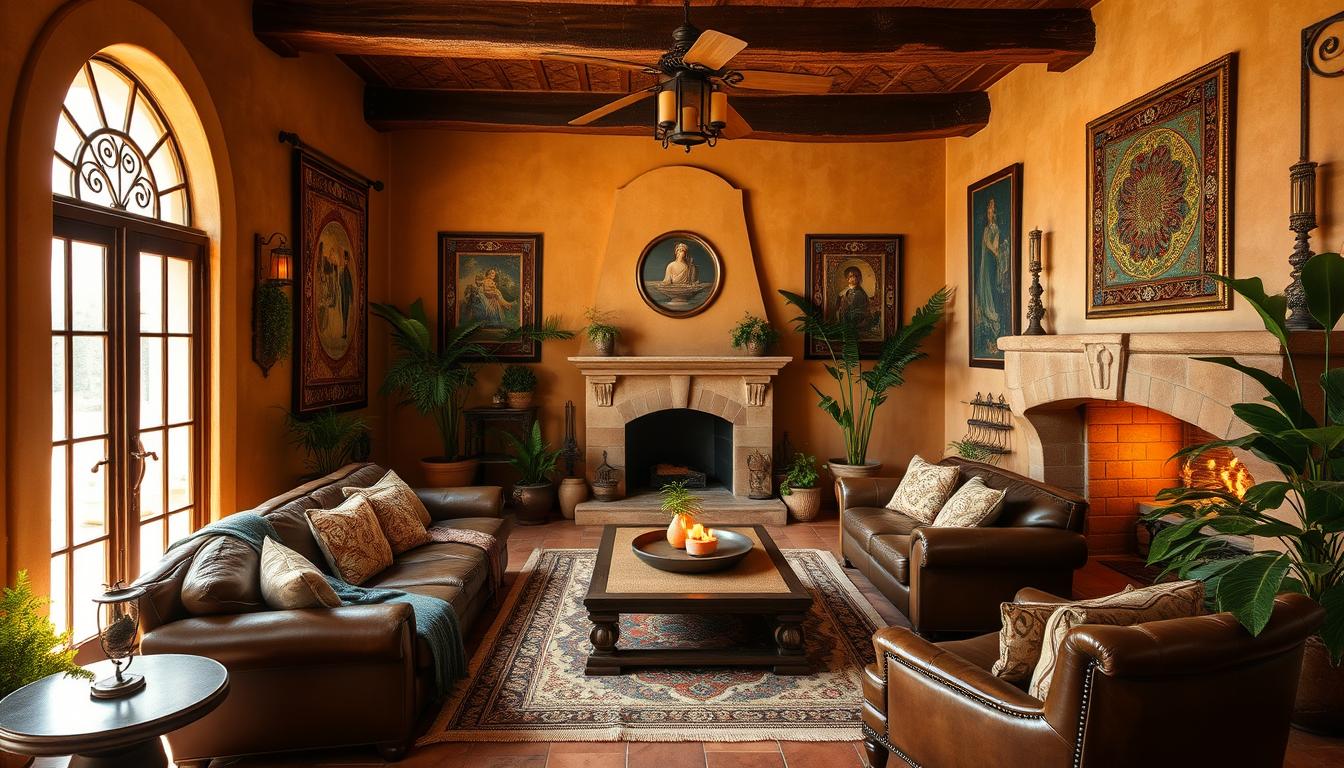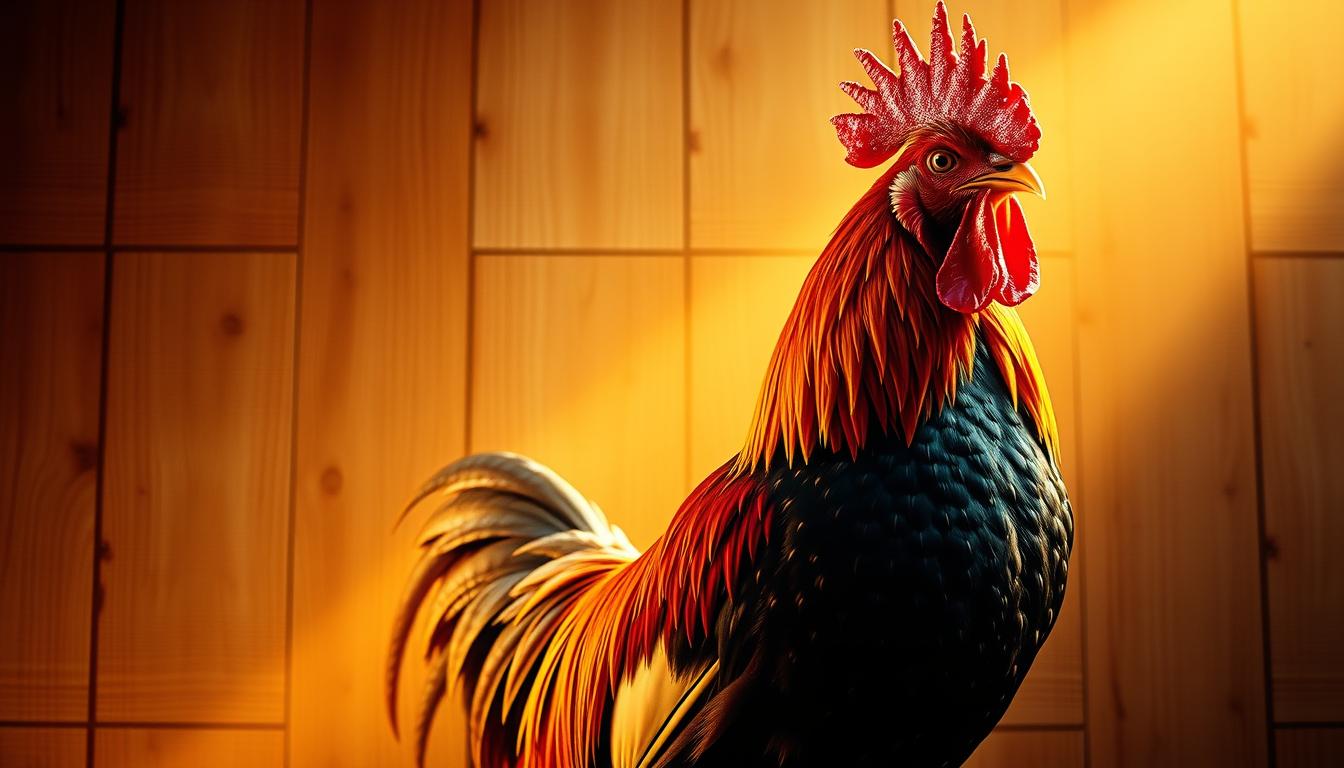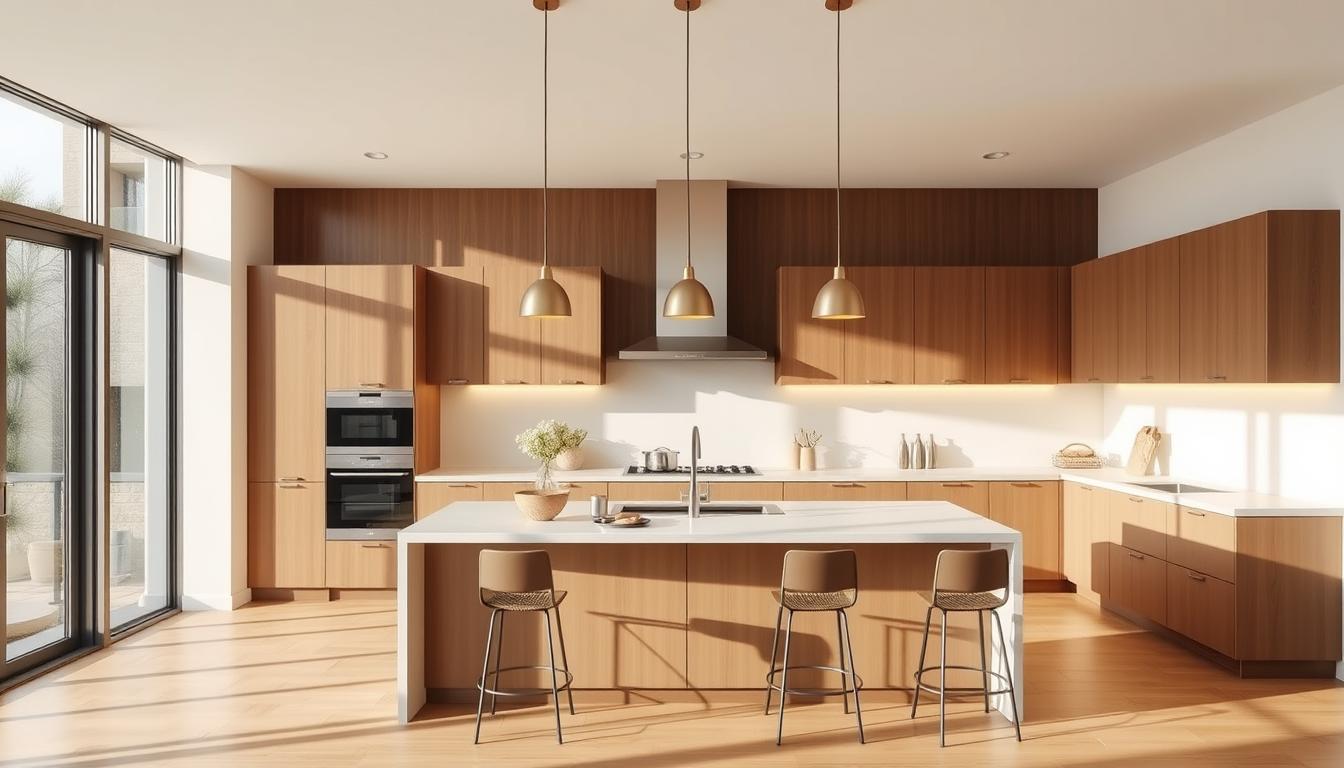Did you know Spanish-style homes are very popular in the United States? They are known for their warm feel and deep cultural roots. These homes bring a timeless beauty to any space.
We’ll dive into what makes Spanish home decor special. You’ll learn about colorful tiles and wooden accents. Plus, we’ll share tips on how to add these touches to your own Spanish-style interior.
Key Takeaways
- Understand the historical context of Spanish-style interiors.
- Learn how to incorporate traditional Spanish elements into your decor.
- Discover the importance of color and texture in Spanish home decor.
- Explore practical tips for creating a cohesive Spanish-style interior.
- Find inspiration for blending Spanish style with modern design.
Understanding Spanish Home Interior Design
Spanish home design is a mix of elegance and warmth. It draws from many cultures, like Moorish, Gothic, and Mediterranean. This creates a style that’s both rustic and sophisticated.
The Rich History Behind Spanish Interiors
The history of Spanish interior design is rich and varied. The Moorish influence shows in intricate tile work and ornate ceilings. The Gothic period brought grand rooms and heavy, ornate furniture.
Spanish design has changed over time, keeping its unique feel. It combines different styles, using natural materials, warm colors, and detailed designs.
Key Characteristics of Spanish Design
What makes Spanish interior design special? It often uses warm, earthy tones like terracotta and sienna. These tones make spaces cozy and inviting. Ornate details, like wood carvings and tile work, add depth and interest.
- Use of natural materials, such as wood and stone
- Incorporation of traditional elements, like wrought iron and handmade ceramics
- Emphasis on creating a warm, welcoming atmosphere
Knowing the history and key traits of Spanish design helps us see its charm and elegance. Whether you want a rustic or modern Spanish look, these elements will guide you to a beautiful space.
Color Palettes for Spanish Interiors
Spanish interiors mix warm, earthy tones with bright colors. This mix shows Spain’s rich culture and history. It’s not just pretty; it tells a story.
Warm and Earthy Tones
Warm and earthy tones are key in Spanish design. They remind us of Spanish terracotta and landscapes. These colors make homes feel cozy and welcoming.
Some important warm and earthy tones are:
- Terracotta reds, which add warmth and comfort.
- Earthy browns, for a natural and cozy feel.
- Soft ochres, for a warm and inviting vibe.
Pops of Vibrant Colors
While warm tones are common, vibrant colors add excitement. Colors like cobalt blue and fiery reds reflect the Mediterranean and Spanish passion. They make a bold statement.
Vibrant colors are used in:
- Decorative tiles, a Spanish design staple.
- Textiles, like vibrant rugs and colorful throw pillows.
- Wall art, with bold colors in paintings and ceramics.
The Role of Neutrals in Balance
Neutrals are key to balancing bold colors in Spanish interiors. Shades of white, cream, and beige cool down the space. They prevent the colors from feeling too much.
Neutrals are used in many ways, including:
- Wall paint, for a calm background.
- Furniture, like neutral-colored sofas and chairs.
- Textiles, like white or beige linens, for simplicity.
By mixing warm tones, vibrant colors, and neutrals, Spanish interiors become unique and inviting. They are both beautiful and deeply rooted in tradition.
Furniture Selection in Spanish Homes
To capture the spirit of Spanish design, choose furniture that reflects the country’s rich culture. Spanish homes are known for their warm, inviting atmospheres. The right furniture pieces are key to creating this ambiance.
Iconic Spanish Furniture Styles
Spanish furniture is known for intricate carvings, ornate metalwork, and classic designs. These styles have been passed down through generations. Some iconic styles include:
- Baroque: Characterized by elaborate ornamentation and dramatic details.
- Moorish: Influenced by Islamic art, featuring geometric patterns and intricate tile work.
- Renaissance: Marked by a revival of classical Greek and Roman styles, with an emphasis on symmetry and proportion.
Integrating Global Influences
While traditional Spanish furniture is stunning, adding global influences can make your home unique. Consider pieces that reflect your travels or cultural heritage. Blend them with Spanish styles for a personalized space.
| Furniture Style | Characteristics | Global Influence |
|---|---|---|
| Spanish Colonial | Ornate carvings, heavy woods | Latin American |
| Moorish | Geometric patterns, tile work | North African |
| Modern Spanish | Clean lines, minimalist decor | International Modernism |
Choosing Quality Materials
The quality of materials in your furniture greatly affects your Spanish home’s look and durability. Look for solid woods like oak or walnut, and metals like wrought iron.
By focusing on these aspects, you can create a Spanish home that is both beautiful and functional. It will reflect Spain’s rich cultural heritage and your personal style.
Textiles and Fabrics for Spanish Aesthetics
Rich textiles and fabrics are key in Spanish interior design. They add warmth and depth to any room. In traditional Spanish homes, these textiles tell stories of culture and history.
Traditional Fabrics and Their Significance
Spanish interiors showcase a variety of traditional fabrics, each with its own story. Silk is loved for its luxury and is used in fancy furnishings and drapes. Wool brings warmth and lasts long, making it perfect for rugs and seats. Cotton is used for linens and casual items because it’s breathable and comfy.
| Fabric | Characteristics | Common Uses |
|---|---|---|
| Silk | Luxurious, smooth, lustrous | Drapery, upholstery, high-end furnishings |
| Wool | Warm, durable, textured | Rugs, upholstery, blankets |
| Cotton | Breathable, soft, versatile | Linens, casual upholstery, curtains |
Layering for Texture and Comfort
Layering different textiles is crucial for Spanish interiors’ inviting feel. Mixing fabrics, textures, and patterns adds depth and interest. For example, a wool rug with cotton linens and silk drapes creates a cozy, Spanish look.
To layer textiles well, follow these tips:
- Mix different textures, like smooth silk and rough wool.
- Vary patterns, combining stripes with solids or florals.
- Play with scales, using large rugs under smaller, intricately patterned throw blankets.
By carefully choosing and layering traditional Spanish textiles, homeowners can make a warm, authentic space. This space reflects Spain’s rich cultural heritage.
Incorporating Decorative Elements
Decorative elements are the heart of Spanish interiors, adding warmth and character. They reflect Spain’s rich culture and make your home feel authentic.
Handcrafted Pottery and Ceramics
Handcrafted pottery and ceramics are key in Spanish decor. They come in vibrant colors and detailed designs. Use them to brighten up your shelves or as practical items like vases and plates.
Choose pottery that shows off traditional Spanish skills. Look for pieces from Andalusia or Catalonia.
Tips for Incorporating Pottery:
- Mix and match different patterns and colors to create a visually appealing display.
- Use larger pieces as statement items on a console table or sideboard.
- Group smaller items together in a decorative bowl or on a tiered server.
The Importance of Wall Art
Wall art is crucial in Spanish interiors. It often includes religious icons, Moorish patterns, and bold abstract designs. Choose art that shows Spain’s rich history and culture.
To create a focal point in your room, consider a large piece of wall art or a collection of smaller pieces arranged in a collage.
Using Mirrors to Enhance Space
Mirrors are smart decorative pieces that make rooms look bigger and brighter. In Spanish decor, mirrors are often beautifully framed. Hang a large mirror opposite a window to reflect light and views. Or, use a set of smaller mirrors for a decorative gallery wall.
By adding handcrafted pottery, meaningful wall art, and mirrors, you can make your home feel Spanish and stylish.
Lighting Choices for a Spanish Vibe
Getting the right lighting is key to a Spanish-style home’s ambiance. Lighting can change a space’s feel, making it cozy or modern. In Spanish design, lighting is more than just useful; it adds to the home’s rustic charm.
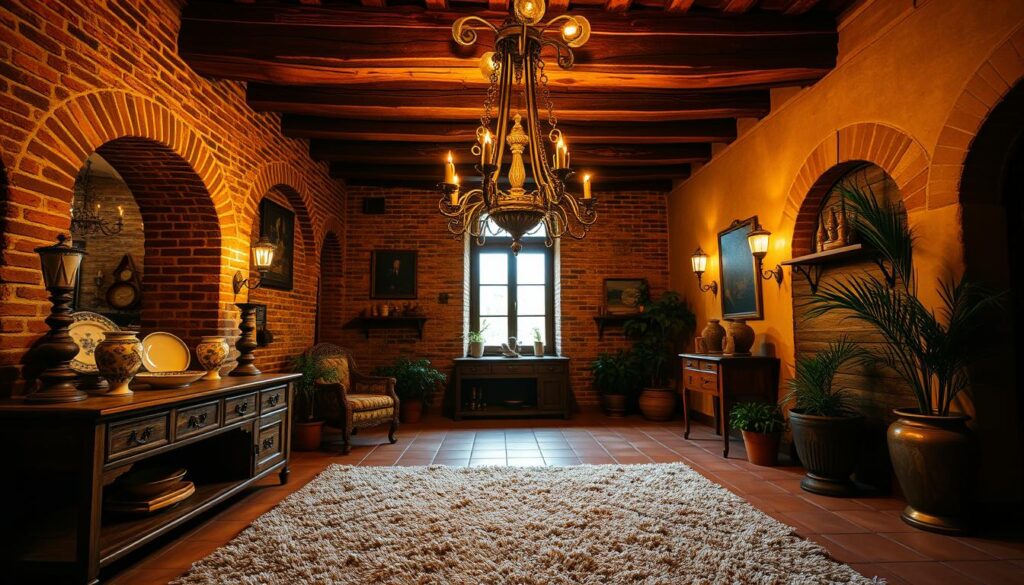
Embracing Natural Light
Spanish architecture loves natural light. Big windows, courtyards, and open spaces let sunlight in. This makes rooms bright and welcoming.
Using sheer curtains or blinds helps bring in more sunlight. This way, you don’t need as much artificial light. It also shows off your decor’s beauty.
Statement Lighting Fixtures
Artificial lighting is also important for the right vibe. Ornate chandeliers or rustic pendant lights add elegance to your home.
“Lighting is a crucial element in interior design, and in Spanish-style homes, it can make a significant statement.”
Choose lighting that reflects Spain’s rich culture. Look for pieces in materials like wrought iron, copper, or wood. They add warmth and character.
Layering Different Sources of Light
Layering light sources makes your space interesting and functional. In a Spanish home, mix overhead lighting with table lamps, floor lamps, or candles.
- Overhead lighting gives general light, like chandeliers or recessed lighting.
- Table and floor lamps add task light, perfect for reading or highlighting decor.
- Candles and soft lights warm up the space, creating a cozy feel.
Layering light sources creates a welcoming atmosphere typical of Spanish interiors. It also lets you change the mood for different times.
| Lighting Type | Purpose | Examples |
|---|---|---|
| Overhead Lighting | General Illumination | Chandeliers, Recessed Lighting |
| Task Lighting | Reading, Highlighting Decor | Table Lamps, Floor Lamps |
| Ambient Lighting | Creating Ambiance | Candles, Soft LED Lights |
In conclusion, lighting is key to a Spanish vibe in your home. Use natural light, statement fixtures, and layered lighting to create a warm, inviting space.
Flooring Options that Define Spanish Interiors
The right flooring can make or break the Spanish interior design aesthetic. It brings warmth and authenticity to a space. Flooring is a crucial element that can significantly impact the overall ambiance of a home.
Choosing Authentic Tiles
Authentic Spanish tiles, known as “azulejos,” are a hallmark of Spanish interior design. These tiles are not only beautiful but also steeped in history and culture. When selecting tiles, consider the color palette and pattern that will complement your space.
Types of Authentic Spanish Tiles:
- Glazed ceramic tiles
- Terracotta tiles
- Mosaic tiles
Natural Stone vs. Wooden Floors
Both natural stone and wooden floors are popular choices for Spanish interiors. Natural stone, such as marble and limestone, offers durability and a timeless look. Wooden floors, made from oak or walnut, add warmth and character to a room.
| Flooring Material | Durability | Aesthetic Appeal |
|---|---|---|
| Natural Stone | High | Timeless, elegant |
| Wooden Floors | Medium | Warm, inviting |
Area Rugs for Added Warmth
Area rugs can add a layer of warmth and texture to your Spanish interior. Choose rugs that complement the existing color palette and style of your flooring. Consider traditional Spanish patterns and motifs to enhance the authenticity of your design.
Tips for Selecting Area Rugs:
- Select rugs with traditional Spanish patterns
- Consider the color and texture of the rug in relation to your flooring
- Layer rugs for added depth and warmth
Bringing the Outdoors In
Spanish homes are famous for mixing indoor and outdoor spaces. This creates a sense of peace with nature. It’s a key part of mediterranean home decor, making rooms feel welcoming and open.
Designing Spanish Courtyards
Courtyards are a big part of Spanish homes. They are calm spots with plants, fountains, and colorful tiles. For more tips on Spanish-style interiors, check out our guide on Spanish home interior design.
Courtyards look great and are useful for relaxing and having fun. To make a real Spanish courtyard, add native plants, terracotta pots, and fancy ironwork.
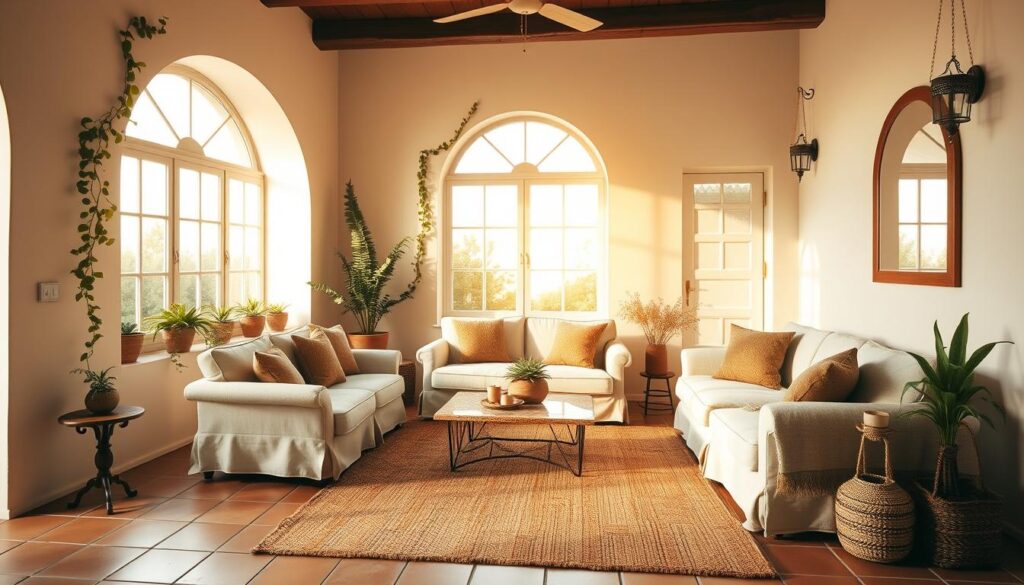
The Role of Indoor Plants
Indoor plants are important in Spanish homes. They add beauty and fresh air to rooms. Popular plants include olive trees, citrus, and herbs like rosemary and lavender.
Choose plants that fit your light and care needs. Grouping plants makes a space feel green and lively, like the outdoors.
Utilizing Windows and Balconies
Windows and balconies connect indoor and outdoor spaces. Big windows let in lots of light. Balconies extend living areas outside.
To link spaces better, use the same flooring inside and out. Consider big glass doors or bi-fold doors for a smooth transition.
“The art of creating a seamless transition between indoors and outdoors is a hallmark of Spanish design, where the boundaries between inside and outside are beautifully blurred.”
Creating a Cohesive Style in Your Home
Making your Spanish-style home look good is about mixing old and new. This mix makes your home welcoming and shows off your style.
Balancing Modern and Traditional Elements
To get a modern Spanish home interior right, mix old and new. Pick a few key pieces that show off Spanish style, like carved wood or colorful tiles. Then, add modern touches like sleek lights or art to bring in sophistication.
Think about what look you want. For example, pair a traditional sofa with modern chairs for contrast. You can also refresh old decor with new materials or colors for a modern twist.
Incorporating Personal Touches
Adding your own touches makes your home special. Use family items, art, or unique decor that shows who you are. For instance, show off antique pottery or hang family photos in fancy frames.
Also, try different textures and colors for depth. Use wood, metal, and fabric together. Adding plants or a standout piece of furniture can also warm up your home.
By carefully mixing old and new and adding your own flair, you can make a Spanish-style home that’s both yours and inviting.
Final Touches to Enhance Your Spanish Home
As we wrap up our guide to Spanish-style home interiors, it’s key to think about the final touches. These details make your space come alive. They balance design elements and add to the traditional Spanish feel.
Seasonal Decor Changes
Changing your decor with the seasons keeps your Spanish home lively. In spring and summer, add bright textiles and colorful pottery. For fall and winter, use warm throw blankets and rich linens.
For more ideas on Spanish home decor, check out our guide at https://kaiaruang.com/our-guide-to-crafting-spanish-style-home-interiors/.
Maintaining the Spanish Aesthetic
To keep your Spanish home looking its best, take care of your design. Dust and polish furniture regularly. Also, reapply finishes when needed.
Be careful with the colors and textures you add. Make sure they match your existing traditional Spanish decor.

